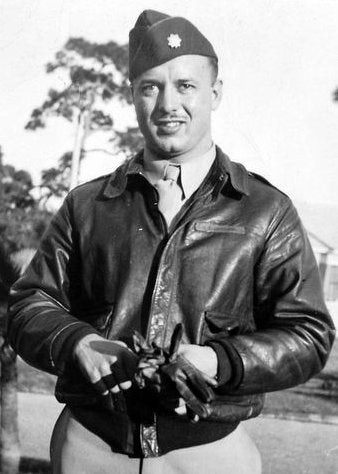- Lieutenant Colonel
- WW II
Biography
Charles “Griff” Edwin Griffith was born in Mott, North Dakota on 24 August 1916. He was the son of Thomas and Bessie Griffith. He graduated from Hope High School, Providence, Rhode Island in 1935 where he was an outstanding scholar and athlete. He was captain of the high school wrestling team and Rhode Island State Champion, as well as a member of the football and track teams. He entered Rhode Island State College (RISC) in September 1935 ma-joring in Mechanical Engineering with the class of 1939. He organized and was Captain of the RISC Wrestling Team, and he was the Intercollegiate Wrestling Champion in 1936. Griff was a member of Sigma Alpha Epsilon Fraternity and participated in the Army ROTC program while a student.
Griff left RISC in June 1937 and was employed with Brown and Sharpe Engi-neering Company for two years prior to enlisting in the U.S. Army Aviation Cadet Program in June 1940. He completed flight training and was commissioned a Second Lieutenant and awarded his aviator wings in February 1941.
Major Griffith’s first combat tour was with the Alaska Defense Command flying P39F Fighters during attacks on the Japanese held Aleutians Islands. In May 1943, U.S. troops retook Attu and three months later reclaimed Kiska; and in the process, the U.S. gained experience which helped them prepare for the long “island-hopping” battles to come as World War II raged across the Pacific Ocean. Major Griffith served eight months in the Aleutians as the Commanding Officer, 42th Fighter “Green Death” Squadron and led the first American raid over Japanese installations at Attu and Kiska. He was awarded the Air Medal for drawing enemy fire to his own plane while permitting U.S. bombers to go undetected during their bombing run against Japanese installa-tions.
Lieutenant Colonel Griffith assumed Command of the 76th Fighter Squadron on 4 May 1944. The 76th Fighter Squadron’s first assignment as an active unit was in the China-Burma-India Theatre. On 19 June 1944, Lt. Col. Griffith led a flight of four fighter aircraft to escort a formation of U.S. bombers on a mis-sion against enemy shipping. A large gunboat was sighted; and when the bombs dropped by the bombers all fell short, Lt. Col. Griffin dive bombed the gunboat and scored direct hits with both bombs from his armed plane. The gunboat burst into flames and sank.
On 10 November 1944, Lieutenant Colonel Charles E. Griffith was awarded the Distinguished Flying Cross.
Distinguished Flying Cross Citation
The Distinguished Flying Cross is awarded to Lieutenant Colonel Charles E. Griffith, Commanding Officer, 76th Fighter Squadron for extraordinary achievement in aerial flight against the enemy. He distinguished himself as a fighter pilot in China during the period: 4 May 1944 to 10 September 1944, participating in over fifty combat missions. He is credited with inflicting heavy losses on the enemy in materiel and personnel, although his missions frequently extended into areas where the enemy maintained numerical-ly superior aerial forces. Fire from enemy ground installations and hostile aircraft were encountered on many flights, but he carried out his assigned mission with efficiency and coolness. The courage and determination exhibited by Lt. Col. Griffith reflect great credit upon himself and are consonant with the finest traditions of the United States Air Force.
Sadly, Lieutenant Colonel Griffith was killed on 14 December 1944. He is credited with shooting down four confirmed enemy aircraft, sinking one en-emy gunboat and participating in over 100 fighter combat missions. Lieutenant Colonel Charles Edwin Griffith was buried with full military honors at Arlington National Cemetery, Arlington, Virginia.
Lieutenant Colonel Charles Edwin Griffith, U.S. Army Air Forces, was a hero in defeating the Japanese as part of the China Task Force. He was another son of Rhode Island and America who answered the call to duty and gave his life during World War II. He is a heroic member of the “Greatest Generation.”
Education
1939

